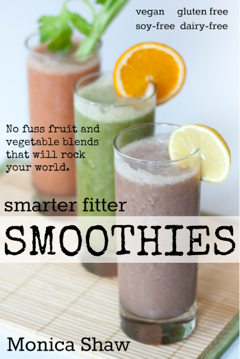 I’ve been hitting the protein smoothies lately. Why? Because I’ve also been hitting the pushups and pull-ups and I think a little extra protein can only do this vegetarian some good. I used to drink smoothies all the time as a little reward after finishing a long run. Now I find them to be a great mid-morning snack to get me through til lunch.
I’ve been hitting the protein smoothies lately. Why? Because I’ve also been hitting the pushups and pull-ups and I think a little extra protein can only do this vegetarian some good. I used to drink smoothies all the time as a little reward after finishing a long run. Now I find them to be a great mid-morning snack to get me through til lunch.
Today, Crabby posted her Simplest Smoothie Recipe Ever recipe and it inspired me to share my own. She doesn’t use ice in hers but I like to add a good 4-6 cubes per person for a thick frothy milkshake that’s a little slow-going through a straw (this keeps me from downing my smoothie in one gulp). I also like to add a few dried pieces of fruit such as prunes or date… the blender chops them into little bits that are fun to eat, and any large bits that don’t get blended are like a nice fruity surprise at the end.
The protein part usually comes from unsweetened protein powder, either whey or soy (tried pea protein once – yuck). If I’m out of powder, I use tofu or yogurt. My preference is for tofu (shown above) or soy protein powder, both of which seem to result in a creamier smoothie than other options.
I don’t find that this needs any extra sweetener; usually the frozen fruit is sweet enough. But if you like a sweeter smoothie, add some honey or substitute the water for fruit juice.
Easy Protein Smoothie
Serves 2
3 scoops protein powder (or 1 350g block of silken tofu)
1 banana
200g frozen berries
2-4 dates or prunes
4 Tbsp flax meal
8-12 ice cubes
water, enough to cover
Put everything in the blender and WHIZZ, adding more or less water to achieve the desired smoothie smoothness. Enjoy!


If you’re building muscle, potassium becomes quite important. The banana provides some potassium, and prunes provide quite a bit. A nice baked potato has a ton of potassium. Just a thought.
I first read that as “200 frozen berries” and thought, “Dang, girl!”
What’s the flax meal do?
Leisureguy – interesting factoid about potassium! I actually had a hard time finding anything that explained what potassium actually does. The http://www.hkpp.org/general/potassium_health.html“ rel=”nofollow”>Periodic Paralysis News Desk (whatever that means) does a decent job in layman’s terms:
Charlie – the flax is for fat and fibre. I also like the nutty flavor… tastes kind of like wheat germ (also good in smoothies)!